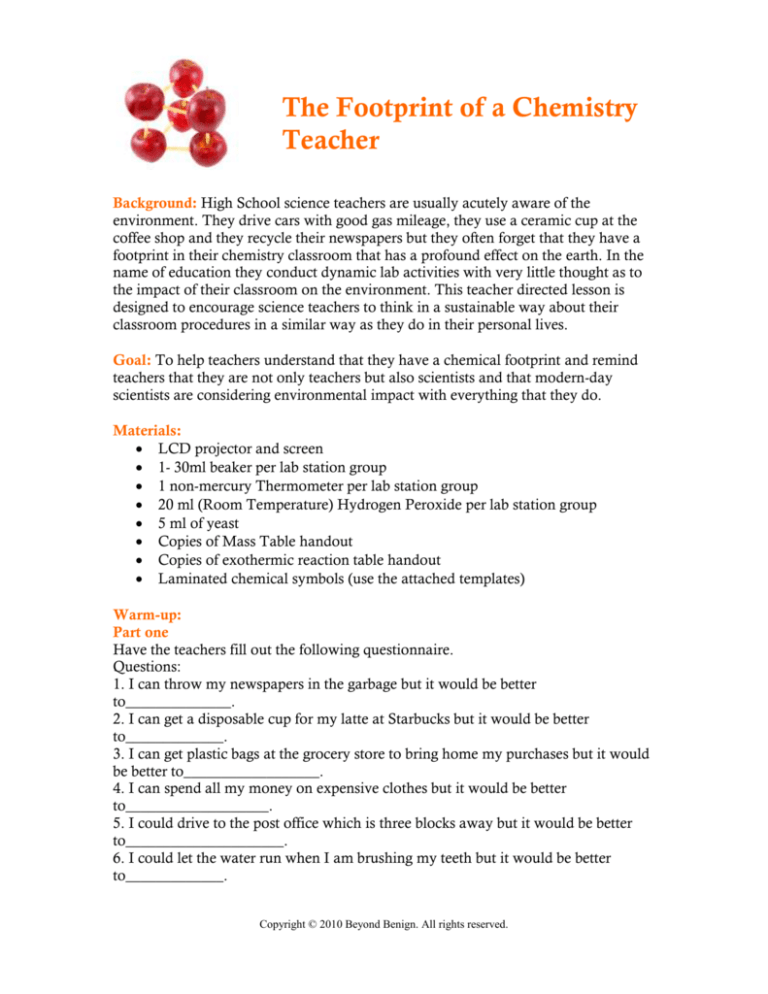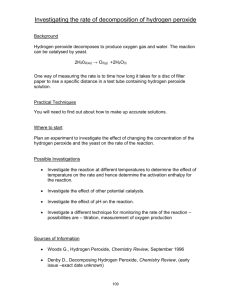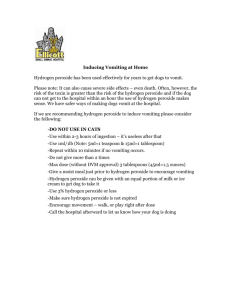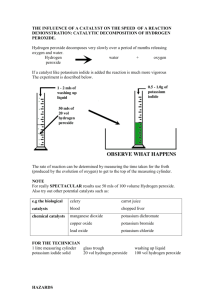
The Footprint of a Chemistry
Teacher
Background: High School science teachers are usually acutely aware of the
environment. They drive cars with good gas mileage, they use a ceramic cup at the
coffee shop and they recycle their newspapers but they often forget that they have a
footprint in their chemistry classroom that has a profound effect on the earth. In the
name of education they conduct dynamic lab activities with very little thought as to
the impact of their classroom on the environment. This teacher directed lesson is
designed to encourage science teachers to think in a sustainable way about their
classroom procedures in a similar way as they do in their personal lives.
Goal: To help teachers understand that they have a chemical footprint and remind
teachers that they are not only teachers but also scientists and that modern-day
scientists are considering environmental impact with everything that they do.
Materials:
LCD projector and screen
1- 30ml beaker per lab station group
1 non-mercury Thermometer per lab station group
20 ml (Room Temperature) Hydrogen Peroxide per lab station group
5 ml of yeast
Copies of Mass Table handout
Copies of exothermic reaction table handout
Laminated chemical symbols (use the attached templates)
Warm-up:
Part one
Have the teachers fill out the following questionnaire.
Questions:
1. I can throw my newspapers in the garbage but it would be better
to______________.
2. I can get a disposable cup for my latte at Starbucks but it would be better
to_____________.
3. I can get plastic bags at the grocery store to bring home my purchases but it would
be better to__________________.
4. I can spend all my money on expensive clothes but it would be better
to___________________.
5. I could drive to the post office which is three blocks away but it would be better
to_____________________.
6. I could let the water run when I am brushing my teeth but it would be better
to_____________.
Copyright © 2010 Beyond Benign. All rights reserved.
Tell them to save their answers and we will be discussing them later.
Part two:
Ask the teachers to quickly group the elements they have on the table in front
of them in any way that they see fit.
o H—hydrogen
o Ne –Neon
o Cd—Cadmium
o Hg—Mercury
o O—Oxygen
o S—Sulfur
o Ar—Argon
o Si—Silicon
o N—Nitrogen
o Ca—Calcium
o Pb—Lead
o Al - Aluminum
(Cadmium, Lead and Mercury are the chemicals that should be grouped together as
they are highly toxic and have a negative impact on the environment)
Procedure:
Show the following youtube video.
http://www.youtube.com/watch?v=uaB70TgLfqs&feature=related
Ask the teachers to tell you what the subject of the lesson is and the topic of
lesson. Ask them what concept is being brought to students by performing or
observing this lesson.
The concepts of the lesson:
Chemical reaction
Decomposition
Exothermic reaction
Dehydration of sucrose
11C12H22O11(s) + 11H2SO4(l) 12 C(s) + 11(H2SO4 . H2O)(g)
Now ask the teachers to tell you what they started with – sugar (sucrose—
C12H22O11) and Sulfuric acid( H2SO4)
Discuss where those two chemicals come from
Now ask the teachers what they end up with at the end of the experiment.
What would they do with what they have leftover.
How would they clean up the “product” , equipment, and lab area
Answer: Denature [Neutralize] the sulfuric acid with sodium
bicarbonate(baking soda) after you have finished. Disposal: Add acid to water to
dispose; once the acid is neutralized the carbon mass can be placed in normal trash once
cool.
Copyright © 2010 Beyond Benign. All rights reserved.
Tell the teachers that you have done this experiment before and when you
weighed the black sausage-like substance the mass was about 10g .
Share the definition of Chemical Footprint with the teachers.
o Definition: Chemical footprint: The chemicals consumed, produced,
and modified by an entity. Pertains to chemical interaction between an
entity and it's environment.
Ask teachers in their groups to use the table to calculate their chemical
footprint and discuss it with their group.
Explain that this experiment looks very exciting and interesting, but you
might be feeling some guilt over certain substances used and produced. You
may even sense that there is a fair amount of danger in this lab, so why not
just start and end with safe things?
Explain that in the world of Green Chemistry we consider this sort of
experiment ‘chemistry gone bad’.
This is a dangerous and out of control reaction. It gives off a noxious gas(
sulfuric acid plus H2O)
Explain that this reaction is similar to the one that happened in Bhopal, India
– an exothermic reaction that went out of control. Water was inadvertently
spilled into a vat that reacted and caused 40 tonnes of the deadly gas,
methyisocyanate to be released.
Show the picture and read the description of what happened in Bhopal in
1984.
THAT NIGHT,
DECEMBER 3, 1984
Shortly after midnight poison gas leaked from a factory in Bhopal,
India, owned by Union Carbide Corporation. There was no
warning, none of the plant's safety systems were working. In the
city people were sleeping. They woke in darkness to the sound of
screams with the gases burning their eyes, noses and mouths. They
began retching and coughing up froth streaked with blood. Whole
neighborhoods fled in panic, some were trampled, others
convulsed and fell dead. People lost control of their bowels and
bladders as they ran. Within hours thousands of dead bodies lay in
the streets
From www.bhopal.net
Chemistry is a great thing but like many great things it can be potentially
hazardous to humans and the environment and as such we need to make sure
we are responsible with this great thing.
Copyright © 2010 Beyond Benign. All rights reserved.
But you’re saying, “I have to teach exothermic, endothermic and
decomposition reactions.”
Let me show you a very simple example of an exothermic reaction using only
things we could buy at the local grocery store.
Lead the teachers through the following lab procedure:
Lab
Use the following materials on your desk:
1- 50 ml beaker per lab station group
1 non-mercury Thermometer per lab station group
5 ml (Room Temperature) Hydrogen Peroxide per lab station group
¼ teaspoon of active-dry yeast
Procedure:
Place 5 ml of hydrogen peroxide into the beaker
Place thermometer into the hydrogen peroxide and record the starting
temperature in Data table I
Add the ¼ teaspoon of yeast
Record temperature changes at 15 second intervals in data table I for 3
minutes.
Record ending temperature in data Table I.
Clean up and return all materials. (Materials are non-hazardous. Solids can
be discarded in the trash and liquids in the sink.)
Background:
The chemical formula for hydrogen peroxide is H2O2. It looks pretty similar to the chemical
formula for water, which is H20, except that hydrogen peroxide has an extra "O", an extra
oxygen. Hydrogen peroxide is not a very stable compound, so, it is always decomposing to
water and oxygen, but under normal conditions, the decomposition goes very slowly.
When the yeast and Hydrogen peroxide mix chemically, the hydrogen peroxide changes into
oxygen and water molecules. The bubbles are produced by the oxygen gas escaping during the
chemical change. This change also produces heat.
Ask teachers what other concepts behind chemistry are going on with this
reaction that they could use this lab to teach. (catalysis)
Now ask the teachers to look back at the groups of chemicals they organized
earlier. Explain that as science teachers we are used to students understanding
and classifying properties of matter through the following ways:
Melting point
Boiling point
Color
Copyright © 2010 Beyond Benign. All rights reserved.
Texture
Odor
Mass
Volume
Density
Shape
Conductivity (electric and heat)
Magnetism
Metal/Non-metal
Flammability
Combustibility
Viscosity
pH
The two most important properties of matter are missing and they are:
Toxicity
Impact on the environment
How might we organize the element cards with these two properties in mind?
Every student should be thinking about these two properties of matter first
and that is the first way that all matter should be classified.
Ask the teachers to look back at the questionnaire they filled out. Easy right,
we are all good citizens here and these are no-brainers.
We make these decisions every day and they are regarded as just the way we
need to be in order to be appropriate citizens. So why don’t we do that in our
classrooms? Why do we assume that the only way to show chemistry
concepts is the way that we have always done it? The chemical industry has
changed considerably since we all went to school so it follows that the way we
teach chemistry needs to change also.
The most important reason to not do it that way anymore is that industry is
not doing it that way any more.
A lesson in the new millennium should go like this:
o Before we begin an experiment: How have our starting materials been
made?
o Can we trace them back to renewable resources?
o How much waste is generated from the process?
o What happens to our waste?
o From where do we get the energy needed for the reaction and how is it
generated?
o What was necessary to produce our reaction apparatus?
o Finally we will end up with a complete picture of not only what
happens in our experiment but how our reaction interacts with the
environment.
o In most cases it will be difficult to determine all parameters in exact
measures, but even rough estimates allow the identification of
problems and opportunities for improvement.
Copyright © 2010 Beyond Benign. All rights reserved.
Asking these questions in the teaching laboratory course will change the way
students look at a chemical reaction and prepare them much better for their
professional tasks.
Copyright © 2010 Beyond Benign. All rights reserved.
Teacher Worksheet
‘Guesstimate’ our chemical footprint
Mass of the carbon
sausage
Mass of carbon
sausages used in
your teaching career
Mass of the carbon
sausages used this
year in your home
state
Mass of the carbon
sausages used this
year in the country
Mass of the carbon
sausages used in the
country over the
average lifespan of a
teacher
Mass of carbon
sausages used in the
world in the next 25
years.
Exothermic reaction data table
Starting
Temperature
30 sec.
60 sec.
90 sec.
120 sec.
150 sec.
180 sec.
Beaker
temperature °C
Calculate your chemical footprint
What were
my starting
materials?
How much
water did I
use?
What was my
process?
What are your
ending
materials?
What can
be reused?
How much
energy did I
use?
Copyright © 2010 Beyond Benign. All rights reserved.
What can be
recycled?
What will
need to go in
the trash?
What is the efactor?
Copyright © 2010 Beyond Benign. All rights reserved.
Pb - Lead
Al - Aluminum
Copyright © 2010 Beyond Benign. All rights reserved.
H - Hydrogen
S - Sulphur
Ca - Calcium
Ne - Neon
Cd - Cadmium
Hg - Mercury
O - Oxygen
Ar - Argon
Si - Silicon
N - Nitrogen
Copyright © 2010 Beyond Benign. All rights reserved.









